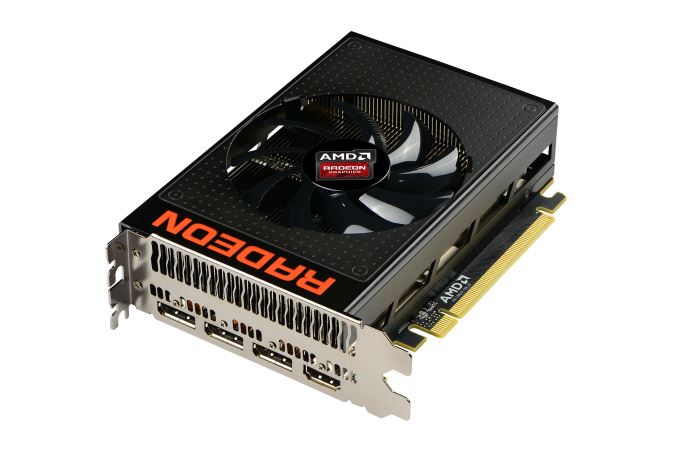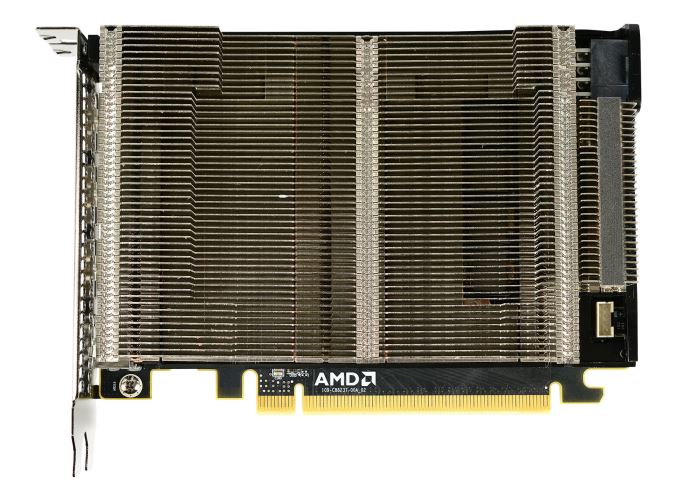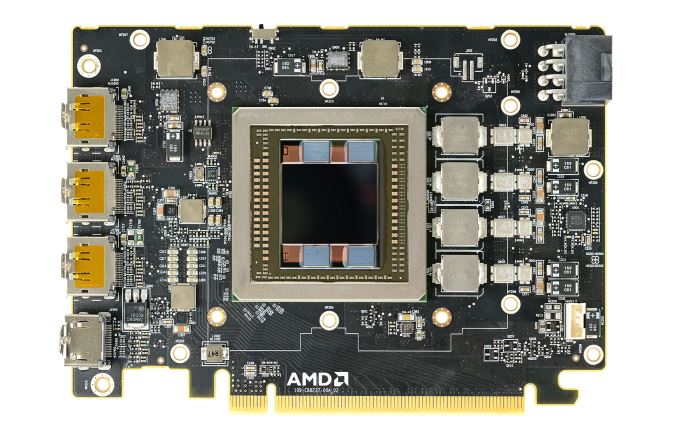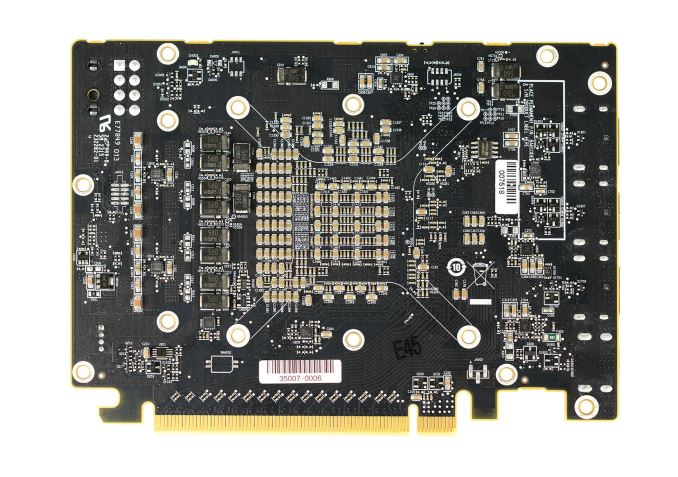The AMD Radeon R9 Nano Review: The Power of Size
by Ryan Smith on September 10, 2015 8:00 AM ESTMeet The Radeon R9 Nano
6 inch video cards are by no means a new thing in the GPU space, however these are traditionally lower-end products that need neither a large cooler nor an extensive power delivery system. As a result the R9 Nano is something of an interesting aberration, packing a lot more power and a lot more technology into half a foot of video card than what we normally see.
Starting as always from the top, the R9 Nano measures 6” long, which is actually a bit shorter than the full length the Mini-ITX standard allows. Responsibility for cooling the card falls to the R9 Nano’s new open air cooler, an aggressive design that has been specifically tailored to allow the card to effectively dissipate 175W of heat in such a small space.
The overall design of the R9 Nano’s cooler is best described as a combination open-air and half-blower hybrid. The design is technically open-air, employing a single axial fan to cool the card. However with only a single fan AMD has been able to align the heatsink fins horizontally and then place the fan in the center of the heatsink. The end result is that roughly half of the heat produced by the card is vented outside of the case, similar to a full blower, while the other half of the heat is vented back into the case. This reduces (though doesn’t eliminate) the amount of hot air being recycled by the card.
The heatsink itself is composed of aluminum and runs virtually the entire length of the card. This is technical a two-piece heatsink, with the primary heatsink composing the bulk of the card, while a much smaller secondary heatsink it found towards the far end of the card and mounted on top of a heatpipe.
Drilling down, we find that the primary heatsink is fed by a combination vapor chamber and heatpipe design. A copper vapor chamber serves to draw heat away from the Fiji GPU and HBM stacks, and then heatpipes are used to better distribute heat to the rest of the heatsink. The use of a vapor chamber in the R9 Nano makes a lot of sense given the fact that vapor chambers are traditionally the most efficient heatsink base type, however the R9 Nano is also unique in that we typically don’t see vapor chambers and heatpipes used together. Other designs such as the high-end GeForce series use a single large vapor chamber across the entire heatsink base, so among reference cards at least the R9 Nano stands alone in this respect. In this case given AMD’s design goals for size and noise, a vapor chamber will play a big part in helping the small card effectively and quietly dissipate 175W.
As for the physical PCB itself, as we can see AMD made it a relatively packed card in order to get the R9 Nano down to 6 inches. Compared to the R9 Fury X reference board, the biggest change here is that AMD has removed a fair bit of power circuitry to save space. By our count there are 4 VRM phases to feed the Fiji GPU, as opposed to the 6 found on R9 Fury X. Power delivery is handled by a single 8-pin PCIe power socket, which is becoming increasingly common, replacing the 2x 6-pin setup for 150W-225W cards.
Meanwhile to further shrink the overall PCB footprint, AMD has moved some of the remaining power delivery circuitry to the back of the card. The front of the card still contains the inductors and heat-sensitive MOSFETs, while a number of capacitors are on the rear of the card (and is why you won’t find a backplate).
Finally, for display I/O R9 Nano is unchanged from R9 Fury X. This means we’re looking at a DVI-free design, with 3x DisplayPort 1.2 and 1x HDMI 1.4 port all along a single row of the I/O bracket. Buyers looking to put together HTPCs will want to be especially mindful of the HDMI 1.4 port; while it's not necessarily a deal-breaker, it does mean that the R9 Nano can't fully drive 4Kp60 TVs, which are slowly but surely becoming more common.
Overall AMD is rather confident in their design for the R9 Nano. The heatsink is built to efficiently dissipate more heat than the 175W the card requires (despite the small size), and as a result we never see the R9 Nano thermally throttle under normal operation. The card’s thermal throttle point is 85C, and in our testing the card never passed 75C, exactly as AMD promised us. What ends up limiting the R9 Nano’s performance then is exactly as expected: the power throttling.
















284 Comments
View All Comments
D. Lister - Friday, September 11, 2015 - link
It is interesting how the ratio of AMD fans on every tech website is about 50/50 with Nvidia fans, yet AMD's market share has dropped below 20%. What's up with that? Either a lot of you AMD guys aren't putting your money where your mouth is, or it's like the same 3 fanboys posting their stuff everywhere with multiple accounts. :pMathos - Friday, September 11, 2015 - link
Not really a fanboy of either side. I'm usually a fan of whatever will give me the best performance at the price point I can afford. Though currently I'm running an AMD HD7850 2GB, because thats what was best at below 200$ at the time I bought it.itproflorida - Friday, September 11, 2015 - link
coincidence I am replying to your post, but of course your not a fan but you will buy another amd card, good for you.Mathos - Friday, September 11, 2015 - link
Look I've probably been building and upgrading computer systems, longer than you've been alive there buddy, I've own more video cards than you'll probably ever know. Many of which predate both nVidia and ATI. I'm buying the R9 Fury, because at 550$, it's faster than similarly priced GTX 980's in the games that I have and play. Don't get me wrong, if I could afford more, I'd buy a 980ti. Unlike you, I apparently read bench marks and multiple reviews on such things. Plus I'm not one of these dumb people who buy x brand because they have the fastest top end card.... even though another brand has something faster at the price point I'm looking at.And speculation you say? Even though I've already been using said features with my 7850? Mostly just the frame rate limit settings to save power at the moment. Also.... have you not seen the performance difference with the DX 12vs11 benchmarks on other sites?
D. Lister - Friday, September 11, 2015 - link
@MathosI think there is a misunderstanding here - my statement was based on a general observation, not pointed at anyone in particular. You could attach a hamster wheel to your gpu slot and I wouldn't mind as long as you feed the hamster, not to mention it would work nearly just as well for Project Cars or Witcher 3 for less money. Sorry, couldn't resist. :D
Mathos - Saturday, September 12, 2015 - link
Oh no, wasn't replying to you, was responding to that Florida person on that harsh reply. As far as your's yeah I figured that. It was kind of ironic, that a fan boy came out to attack my choice on the other post though. I'll have to check out the project cars and witcher 3 bench's. Don't play many racing games, other than Grid and Dirt. I still haven't finished Witcher 1, not worried much about Witcher 3 for a while.Beany2013 - Sunday, October 4, 2015 - link
Anyone who publicly describes themselves as a 'pro', and subsequently can't even manage basic grammar and punctuation needn't be listened to. Simple as that.medi03 - Saturday, September 12, 2015 - link
That's because most of the uneducated public with little clue buys nVidia.HollyDOL - Saturday, September 12, 2015 - link
Funny enough, I started to buy nVidia after I become educated in 3D graphics. At that time ATI provided such a terrible developer experience I doubt I'd be able to forgive&forget yet in next few years.medi03 - Sunday, September 13, 2015 - link
nVidia outsold AMD even in Fermi times, with slower, more expensive, more power hungry chips.So, nope, sorry to bust your bubble.